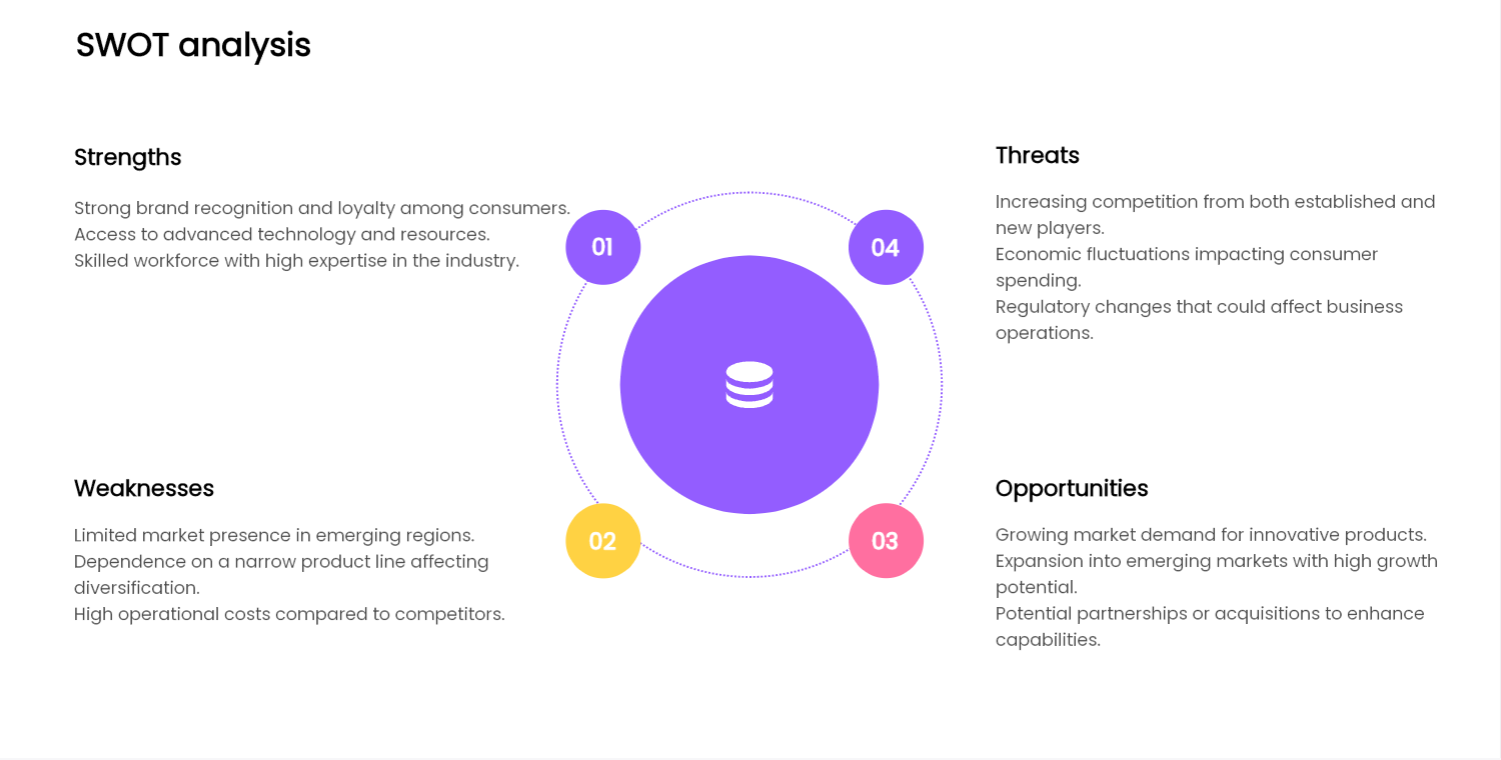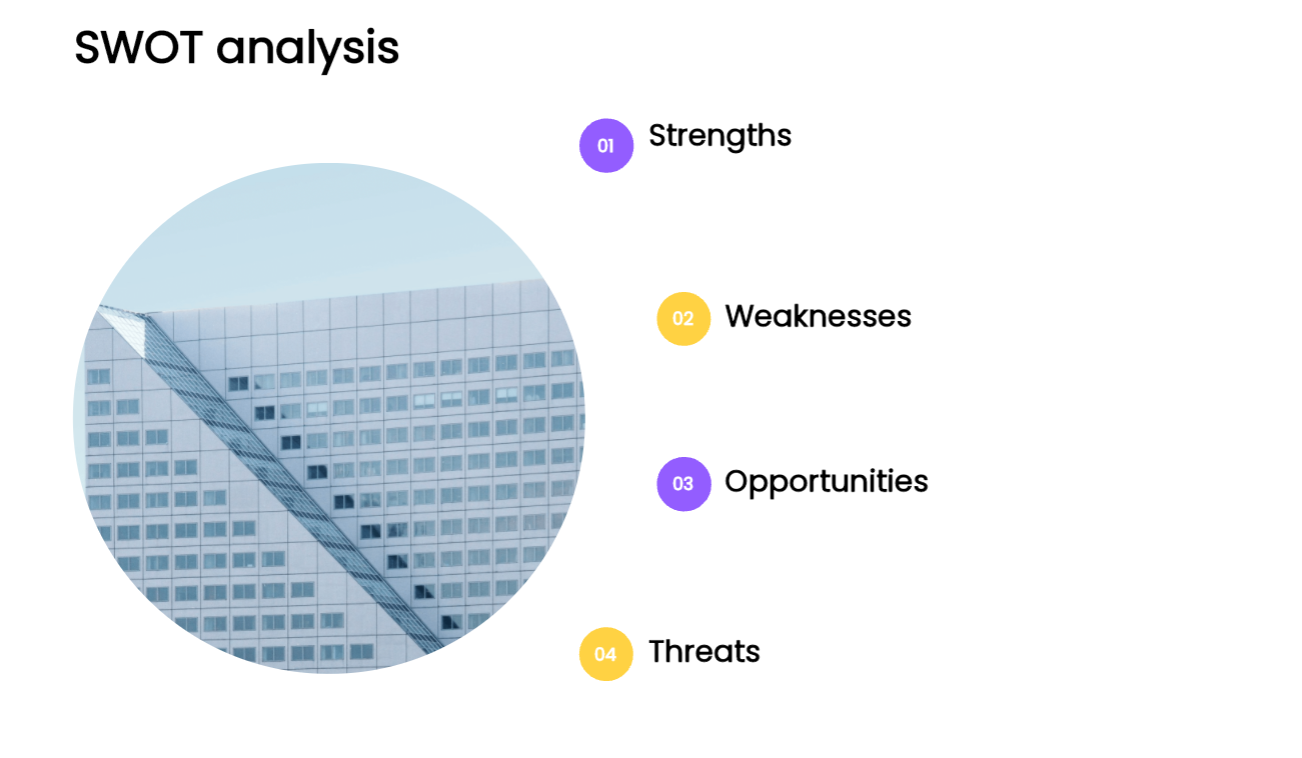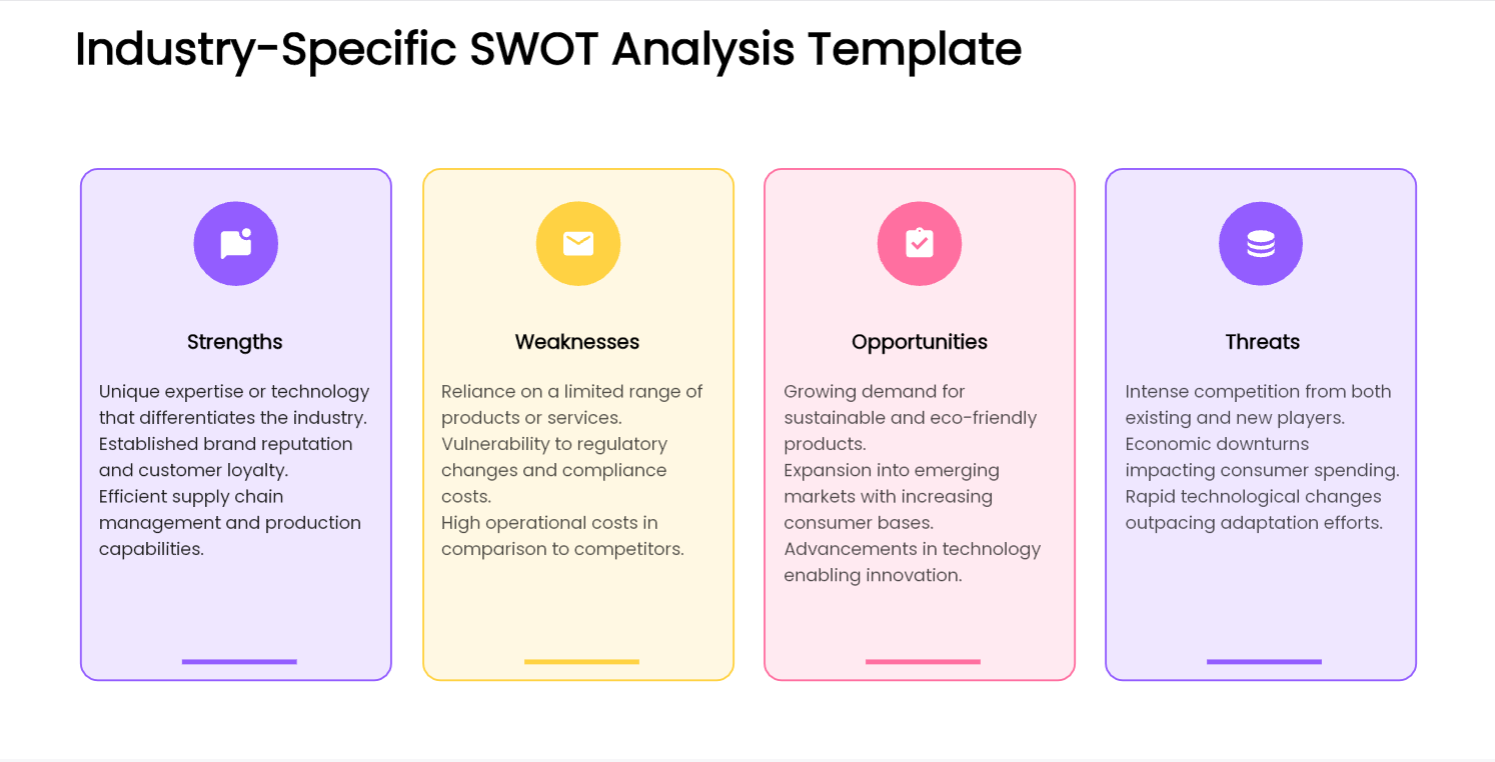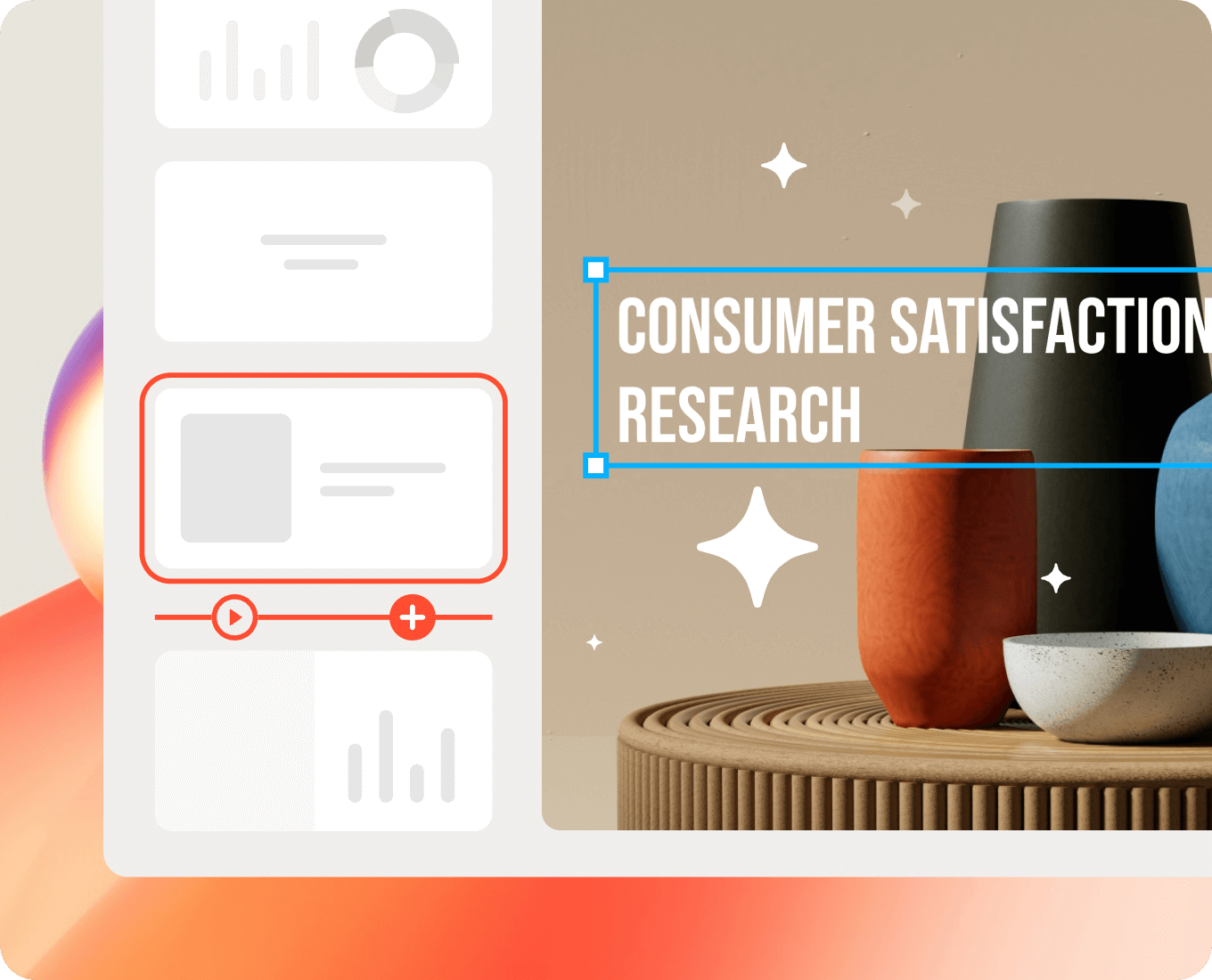In today's competitive landscape, understanding your business environment is crucial for making informed decisions. An excellent tool for achieving this goal is the SWOT analysis. Using a structured SWOT analysis template helps businesses identify their strengths, weaknesses, opportunities, and threats. This blog covers the essentials of SWOT analysis, its implementation, and the benefits of using a template.
What is a SWOT Analysis?

A SWOT analysis is a strategic planning tool that enables organizations to identify and evaluate both internal and external factors that may influence their performance. The acronym stands for:
- Strengths: Internal characteristics that provide a competitive advantage.
- Weaknesses: Factors within the organization that put it at a disadvantage.
- Opportunities: External conditions that can be advantageous for growth.
- Threats: External challenges that could hinder performance.
By systematically assessing these four areas, businesses can make better strategic decisions and identify areas for improvement.
How to Do a SWOT Analysis
Conducting a SWOT analysis involves several key steps:
- Gather a Team: Include members from various departments to gain diverse perspectives.
- Brainstorm Strengths: Identify what your organization does well. Consider resources, capabilities, and competitive advantages.
- Evaluate Weaknesses: Discuss areas where your organization lacks resources or faces challenges.
- Identify Opportunities: Look for potential areas for growth, market trends, and external factors that could benefit your organization.
- Assess Threats: Analyze potential risks, such as market competition, economic shifts, or regulatory changes.
- Document Findings: Use a SWOT template to organize your thoughts and create a clear visual representation of your findings.
Why Use a SWOT Analysis Template?
Using a SWOT analysis template simplifies the process of conducting a SWOT analysis. Here are some compelling reasons to utilize a template:
- Organization: A structured template helps organize thoughts systematically, ensuring that all relevant factors are considered. This organization allows teams to focus on specific areas without overlooking critical components.
- Clarity: Visualizing your analysis makes it easier to communicate findings to stakeholders. A well-designed template presents the information in a clear format, reducing confusion and ensuring everyone is on the same page.
- Efficiency: Templates save time by providing a pre-defined format, allowing teams to focus on content rather than design. This efficiency becomes especially valuable during tight deadlines or when multiple analyses need to be conducted simultaneously.
- Consistency: Using a template ensures that future analyses are conducted similarly, making it easier to track changes over time. This consistency facilitates better comparisons between different SWOT analyses and helps identify trends in strengths, weaknesses, opportunities, and threats.
- Enhanced Collaboration: A shared template fosters collaboration among team members. Everyone can contribute their insights in a structured manner, leading to a more comprehensive understanding of the organization's strategic position.
SWOT Analysis Template Examples
To effectively implement a SWOT analysis, consider using a SWOT presentation template. These templates often include pre-designed slides and charts, making it easy to present your findings clearly and professionally.
Example 1: Basic SWOT Analysis Template

A basic SWOT template typically includes four quadrants, each dedicated to one of the SWOT components. Here's how you might structure it:
- Strengths:
- Strong brand reputation
- Skilled workforce
- Unique technologies
- Exclusive partnerships
- Weaknesses:
- Limited budget
- Outdated technology
- Lack of expertise in certain areas
- High employee turnover rates
- Opportunities:
- Emerging markets
- Technological advancements
- Changing consumer preferences
- Regulatory changes that could benefit the organization
- Threats:
- Increasing competition
- Economic downturns
- Changes in regulations
- Shifts in consumer behavior
Example 2: SWOT Presentation Template
A SWOT presentation template is designed to facilitate effective communication of your findings. This template might include:
- Title Slide: A clear title indicating the purpose of the analysis, along with the date and names of the team members involved.
- Strengths Slide: A bullet-point list or infographic that visually represents strengths, perhaps with icons or charts to enhance engagement.
- Weaknesses Slide: Similar to the strengths slide, this section would highlight weaknesses with a focus on clarity and brevity. Consider using graphics to underscore key points.
- Opportunities Slide: This slide can include a mix of text and visuals, such as graphs showing market trends or images representing potential partnerships.
- Threats Slide: Use visual elements to depict threats, such as a risk matrix or timeline showing when certain threats might impact your organization.
- Conclusion Slide: Summarize key findings and suggest next steps based on the analysis. This slide can encourage discussion on strategic initiatives that leverage strengths and opportunities while addressing weaknesses and threats.
For creating visually appealing presentations, consider using tools like presenti.ai. This platform provides a variety of customizable presentation templates that can enhance your SWOT analysis template PPT. With its user-friendly interface, you can easily integrate your SWOT findings into professional slides, making your analysis more engaging and impactful.
Example 3: Industry-Specific SWOT Analysis Template

Tailored for specific industries, this template allows organizations to focus on relevant factors unique to their sector. For instance, in the technology industry, the template could include:
- Strengths: Innovative product offerings, strong R&D capabilities, established market presence.
- Weaknesses: High dependency on key customers, rapid technological changes, limited market reach.
- Opportunities: Growth in emerging technologies, partnerships with startups, and expansion into international markets.
- Threats: Intense competition, cybersecurity risks, regulatory challenges.
Example 4: SWOT Analysis for Personal Development
This template is beneficial for individual career planning. It could look like this:
- Strengths: Strong communication skills, relevant certifications, extensive network.
- Weaknesses: Limited experience in a specific area, public speaking anxiety, and time management issues.
- Opportunities: Job openings in desired fields, professional development workshops, and mentorship opportunities.
- Threats: Economic downturn affecting job availability, industry changes, competition from other candidates.
Example 5: Visual SWOT Analysis Template
A visual swot analysis template PPT leverages graphics to represent the SWOT components dynamically. This might include:
- Strengths: Illustrated with positive imagery, such as trophies or badges representing achievements.
- Weaknesses: Presented with caution symbols or roadblocks to signify challenges.
- Opportunities: Depicted with arrows pointing upward or lightbulbs to represent new ideas and growth.
- Threats: Shown with storm clouds or warning signs to indicate potential dangers.
Final Thoughts
Mastering the SWOT analysis template is essential for any organization looking to enhance its strategic planning. By effectively identifying strengths, weaknesses, opportunities, and threats, businesses can make informed decisions that lead to sustainable success. Utilizing tools like the Presenti SWOT presentation template can streamline the process and improve clarity in your presentations. Start leveraging these templates today to unlock your organization's full potential!





